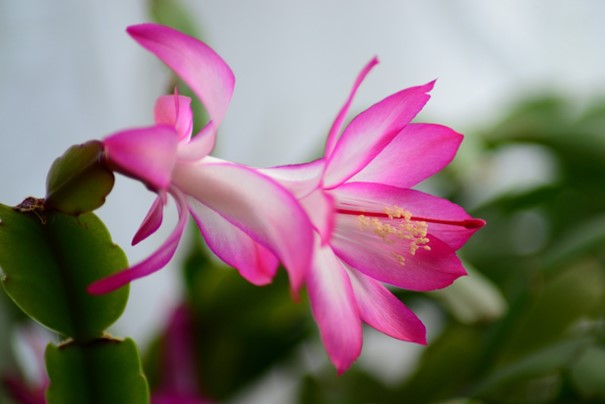Schlumbergera bloom just in time for the holidays (hence their nickname of Christmas cactus), and they're magnificent. Their abundant, colorful blooms and easy care have everything to seduce.
Origin of the Christmas cactus
The parent plant of the Christmas cactus is native to South America, where it grows in the tropical forests of Brazil. Its botanical name, schlumbergera, is a tribute to the French cactus collector Frédéric Schlumberger (1823-1893). Its nickname of Christmas cactus comes from the fact that it usually blooms during the festive season, bringing bright colors into the home during the darker months.


Types of schlumbergera
Schlumbergera are epiphytic plants in the Cactaceae family. But unlike most cacti, they love humidity and can't stand the cold. They produce small, flat, rounded stem segments, vaguely serrated on both sides. And superb flowers appear at the end of these segments.
The genus comprises six species, all with pink flowers. But there are many hybrids, with flowers in a variety of colors: purple, pink, red, orange or white. The famous Christmas cactus, Schlumbergera x buckleyi, is one such hybrid.

Which Garden ID pot for your Christmas cactus?
In our latitudes, Schlumbergera is mainly grown in pots, as it cannot withstand temperatures below 10°. But you can take it outside in summer, away from direct sun and wind.
The Feeling or Shiny ranges are ideal. You can place the plant you've just bought in them. The different pot sizes - from 11 to 35 cm in diameter - will adapt perfectly to the size of the growing pot.
The new mini Feeling and Origin ranges are ideal for even the smallest specimens.
And the tall Classy pots with insert (35 cm diameter) are ideal for showcasing the drooping stems of older or larger plants.

How to care for a Christmas cactus
Very easy to live with and to grow, this houseplant makes do with very little, but still deserves a minimum of attention if it is to thrive.
☀ Light
Schlumbergera are sensitive to the length of the night. Flower buds start to form and develop as soon as the nights lengthen sufficiently, i.e. in early autumn. Choose a bright location, but without direct sunlight. Too much light causes a reddish discoloration of the stems. On the other hand, too little light can prevent flowering.
💧 Watering and maintenance
During the flowering period (November to January), water regularly, then allow the soil to dry out between waterings (empty the water from the saucer to avoid rotting the roots). At the end of the flowering period, let the cactus rest: space out watering and stop fertilizing. From mid-May to September, place your plant outdoors in a shady spot sheltered from the wind, then bring it indoors in October and don't move it again until the end of flowering (schlumbergera hates being moved).

🌡️ Temperature
Except in summer, keep your Christmas cactus indoors, at a temperature of between 18 and 21°C, close to a window so it can enjoy the light. Beware, however, of draughts.
☠️ Toxicity
The plant is not toxic. However, skin reactions are sometimes observed after contact with hands or eyes.
🦟 Diseases, pests and parasites
Mealybugs are very fond of Christmas cacti. Remove them with an alcohol swab, or treat with an anti-cochineal product.
🗑 Potting and multiplication
Repotting: Generally speaking, repotting every three years is sufficient, as Christmas cacti like to be a little cramped. Re-pot in spring, after flowering, when the roots begin to overflow the pot.
Propagation: The plant can be propagated by cuttings outside the flowering season. Take a segment (at least 3 pseudo-leaves). Leave to dry for a few hours, then replant. Schlumbergera tends to spontaneously produce small roots at the base of its pseudo-leaves.

Frequently asked questions about Christmas cacti
If you can't find the answer you're looking for in this article, don't hesitate to ask your questions in the comments.
How to make a Christmas cactus bloom?
Fertilize every month from April to October. Take it outside in summer, then bring it inside before it gets too cold. For about six weeks before flowering, your Christmas cactus needs 12 to 14 hours of darkness. This means cool temperatures and no light (not even artificial light). You may consider covering it during the day to ensure that it will flower.

Why are the buds on my Christmas cactus falling off?
A change of location with drier air or a major change in light or temperature are among the most common reasons. It's also possible that your cactus isn't getting enough light during the day.
Never fertilize the plant after it has begun to flower, as this may cause the buds or flowers to drop off.

Frequently asked questions about Christmas cacti
If you can't find the answer you're looking for in this article, don't hesitate to ask your questions in the comments.
How to make a Christmas cactus bloom?
Fertilize every month from April to October. Take it outside in summer, then bring it inside before it gets too cold. For about six weeks before flowering, your Christmas cactus needs 12 to 14 hours of darkness. This means cool temperatures and no light (not even artificial light). You may consider covering it during the day to ensure that it will flower.
Why are the buds on my Christmas cactus falling off?
A change of location with drier air or a major change in light or temperature are among the most common reasons. It's also possible that your cactus isn't getting enough light during the day.
Never fertilize the plant after it has begun to flower, as this may cause the buds or flowers to drop off.

Browse the collection